Rechargeable Batteries & Chargers; Now With More Power, And Still Much Cheaper Than Disposables
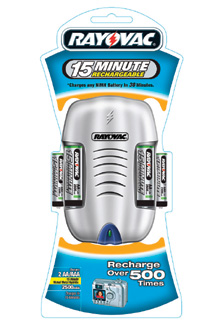 It
wasn't too long ago that Nickel Cadmium (NiCd) technology was all the
rage in rechargeable batteries--until someone discovered that the heavy
metals are an environmental nightmare. As a result, many companies switched
over to Nickel Metal Hydride (Ni-MH), or Nickel Hydride for short (NiHy), which
is arguably more environmentally friendly. NiCd battery systems are not out
of the picture entirely--they're still driving many appliances. And
you may find Ni-MH chargers that can be used with both types of batteries (but
don't assume so if it doesn't say so on the package). Also in vogue
these days are rechargeable lithium ion systems.
It
wasn't too long ago that Nickel Cadmium (NiCd) technology was all the
rage in rechargeable batteries--until someone discovered that the heavy
metals are an environmental nightmare. As a result, many companies switched
over to Nickel Metal Hydride (Ni-MH), or Nickel Hydride for short (NiHy), which
is arguably more environmentally friendly. NiCd battery systems are not out
of the picture entirely--they're still driving many appliances. And
you may find Ni-MH chargers that can be used with both types of batteries (but
don't assume so if it doesn't say so on the package). Also in vogue
these days are rechargeable lithium ion systems.
So, which should you opt for? For starters, not every device works with every
type of battery. Many digital cameras, for example, require a dedicated rechargeable
battery, for which there may actually be non-OEM replacements on the market
(see the camera manufacturer's warnings in this regard). Other cameras
and devices mandate a specific off-the-shelf single-use battery size and voltage,
but as luck would have it, there is often a rechargeable battery replacement
option available here as well. Beyond that are a number of factors that dictate
which battery is right for you.
The Numbers Game
Rechargeable batteries, like many other aspects of our lives, have ratings.
They are rated in mAh, short for milli-Ampere-hours, to indicate how long they
last once fully charged. The higher the number, the longer they last. Of course,
the higher-rated batteries take longer to charge (or recharge), unless used
with a charger specifically supporting these batteries. Among Ni-MH systems,
the magic number that manufacturers aspire to these days is 2500 mAh, which
is a marked improvement over batteries from just a few years ago, which topped
out at 1600. That translates into a charge life of better than 1.5x over the
old batteries. From a practical standpoint, it means more pictures in a digital
camera.
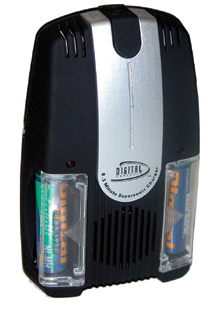 The
other number to watch is voltage. But this is most important among lithium and
lithium ion battery packs, where the voltage must be matched specifically to
the device. The discrepancy between 1.2v on Ni-MH and NiCd and 1.5v on alkaline
and lithium cells is of no practical concern.
The
other number to watch is voltage. But this is most important among lithium and
lithium ion battery packs, where the voltage must be matched specifically to
the device. The discrepancy between 1.2v on Ni-MH and NiCd and 1.5v on alkaline
and lithium cells is of no practical concern.
There are multi-voltage battery systems--I have one where the voltage is
higher than recommended for my digital camera. The package would lead you to
believe that it's safe to use. But not so. Excessive voltage will burn
out a device. As a practical test, I once subjected a small bulb to a multi-voltage
AC adapter. I kept turning up the voltage setting, and was pleasantly surprised
to see the bulb burning brighter and brighter--until it went Pop! And burned
out.
Having said that, we now revisit lithium and lithium ion batteries. Whether
single-use lithium or rechargeable lithium ion, these batteries are not automatic
replacements for alkaline or Ni-MH cells. True, some cameras accept one CR-V3
lithium ion battery in place of two round cells, but that assumes that the camera
(or flash) compartment is configured to hold either. And, we should add that
such devices are designed to run on lithium and lithium ion as well as standard
battery technologies. Many devices, cameras and flash units among them, are
not made to work with these cells. The reason? Lithium has an initial spike
voltage, which would have the same net effect as our little light bulb experience.
If the instruction manual does not specify lithium or lithium ion, don't
use it. Stick with alkaline and Ni-MH.
And never mix two different types of batteries, batteries with different mAh
or voltage ratings, or fresh with partially charged batteries. I would also
make an effort not to mix different brands to maximize the potential of each
individual cell. Unfortunately, battery testers don't do a good job of
reading the condition of rechargeable batteries, so when in doubt, recharge
them before use. However, select charging systems, such as the Ansmann Energy
16 (HP Marketing Corp.) and the La Crosse Technology BC-900 Alpha Battery Charger,
will also test the condition of Ni-MH and NiCd cells as part of the charging
cycle.
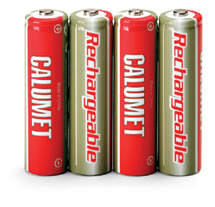 Rechargeable
Battery Maintenance
Rechargeable
Battery Maintenance
Remember to charge rechargeable batteries regularly--at least once a month.
This especially applies to Ni-MH and NiCd. What happens when you allow the batteries
to discharge fully? (Batteries in household appliances are a bit different in
this regard, so follow the manufacturer's instructions.) If the batteries
go into a state of deep discharge--analogous to a human coma, chances are
they won't snap out of it and will have to be discarded (or recycled).
Or they leak from lack of use. That applies to both NiCd and Ni-MH cells. Lithium
ion cells appear to be better insulated against leakage--at least I haven't
seen any such problem to date.
Most rechargeable lithium ion batteries come with some charge out of the box.
You should always give the battery a full charge before first use. Some manufacturers
will tell you to allow the battery to continue charging even after the ready
light comes on, to fully charge the battery. Regrettably, they don't all
say this, so you can't assume it's necessary. What you should not
do is leave the battery sitting in the charger for hours on end, after it's
fully charged--to ensure it remains in peak condition.
With Ni-MH batteries, there is no need to leave the batteries in the charger
after the indicator signals a full charge. If you leave them in longer, they
may go into trickle charge, so they're not depleted--but this depends
on the charger design. Not all chargers boast this feature, so leaving the batteries
in the charger for long periods after charging may leech power from the cells.
It's good practice to remove Ni-MH and NiCd batteries from the charger
once the charge cycle is complete.
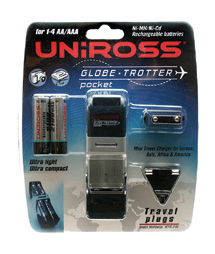 Interestingly,
manufacturers follow different procedures when it comes to initially charging
a set of Ni-MH batteries. One company said to charge their batteries a full
24 hours prior to first use. Other companies instead tell you to charge the
batteries a second time to top them off. And yet others won't recommend
either approach, just telling you to charge for one regular cycle. So be sure
to follow the manufacturer's recommendations. It may also be a function
of the charger, as well as the batteries, which is why it's much simpler
to charge one brand of batteries in the charger they came with and to maintain
some brand loyalty when buying new batteries.
Interestingly,
manufacturers follow different procedures when it comes to initially charging
a set of Ni-MH batteries. One company said to charge their batteries a full
24 hours prior to first use. Other companies instead tell you to charge the
batteries a second time to top them off. And yet others won't recommend
either approach, just telling you to charge for one regular cycle. So be sure
to follow the manufacturer's recommendations. It may also be a function
of the charger, as well as the batteries, which is why it's much simpler
to charge one brand of batteries in the charger they came with and to maintain
some brand loyalty when buying new batteries.
Some Ni-MH/NiCd chargers let you discharge the batteries before charging. This
step is only necessary with NiCd, which suffer from "memory." If
you charge a NiCd battery when only partially discharged, the battery will remember
this level and may not charge fully afterward, not without being reconditioned
with one or more discharge/charge cycles. All indications are that, despite
what you may read on the packaging or in ads, no Ni-MH battery has a memory
problem. Neither does lithium ion. Ni-MH and lithium ion should not be discharged
arbitrarily before charging. And it's a good idea to top off (fully charge)
the batteries before use, if they've been sitting around a while.
And don't forget to switch the device off when not in use, so you don't
needlessly drain the batteries, which could also result in leakage. Store batteries
in a cool, dry place. If you keep them in the fridge, give them time to acclimate
(15-30 minutes) before inserting in a camera, flash, or electronic device to
prevent condensation and to give them time to come back to full capacity. On
the flip side, excessive heat is damaging to batteries, so don't store
them near radiators, heaters, or heat-radiating appliances, such as a toaster
oven.
Fast Or Slow Charge?
Some Ni-MH chargers will charge up to two batteries, but most will accept up
to four round cells--and some as many as eight. Depending on the charger,
batteries will be charged individually, in pairs, or all at once--the number
of LED signals is a good indicator of how this works. The charger may also have
an audible signal, which is helpful--you tend to forget them otherwise.
More beneficial still is a charger that will charge both AAA and AA batteries.
It's rare, but a few chargers will even work with 9v rechargeable Nickel
batteries.
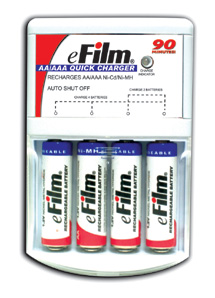 The
issue of speed comes to the fore with Ni-MH chargers. If you read the fine print,
you'll notice a few things. One, the charger may fast-charge only batteries
from the same manufacturer and possibly with a special designation/label. Two,
other batteries will take the normal amount of time to charge, perhaps as long
as overnight. Three, many fast chargers give you the option of slow charging.
Why? Because fast-charging heats up the batteries, which shortens their life.
And this is why such chargers as the Ansmann Digispeed (HP Marketing Corp.)
and Hahnel PowerStation Quattro (RTS Inc.) are fan-cooled. And Lenmar has the
Mach1 Fusion-USB SpeedCharger, which is not only fan-cooled but accepts lithium
ion and Ni-MH batteries. Even tighter control over charging is exercised when
the charger is microprocessor-controlled, an increasingly popular trend in the
age of fast chargers. And if you really like high tech, you'll love the
La Crosse Technology BC-900 Alpha Battery Charger, UNiROSS Sprint 15-minute
LCD, and Varta Platinum--they're each dressed to the nines with a
digital display.
The
issue of speed comes to the fore with Ni-MH chargers. If you read the fine print,
you'll notice a few things. One, the charger may fast-charge only batteries
from the same manufacturer and possibly with a special designation/label. Two,
other batteries will take the normal amount of time to charge, perhaps as long
as overnight. Three, many fast chargers give you the option of slow charging.
Why? Because fast-charging heats up the batteries, which shortens their life.
And this is why such chargers as the Ansmann Digispeed (HP Marketing Corp.)
and Hahnel PowerStation Quattro (RTS Inc.) are fan-cooled. And Lenmar has the
Mach1 Fusion-USB SpeedCharger, which is not only fan-cooled but accepts lithium
ion and Ni-MH batteries. Even tighter control over charging is exercised when
the charger is microprocessor-controlled, an increasingly popular trend in the
age of fast chargers. And if you really like high tech, you'll love the
La Crosse Technology BC-900 Alpha Battery Charger, UNiROSS Sprint 15-minute
LCD, and Varta Platinum--they're each dressed to the nines with a
digital display.
And that brings us to the final question: should you buy one of those new 15-minute,
10-minute, or 8-minute super-fast chargers? Why not? Provided you buy the batteries
designed to go with the charger. The good news is that ultra-fast chargers are
not that expensive. Prices on chargers in general range from around $10-$40
or $50 for a fairly sophisticated Ni-MH system or bare-bones lithium ion charger,
and upward of $70-$100 and more if you're really into high tech or need
more capable lithium ion technology. Chargers often come with batteries. Select
Ni-MH systems even come with adapters to convert AA for C- and D-cell usage.
- Log in or register to post comments

































